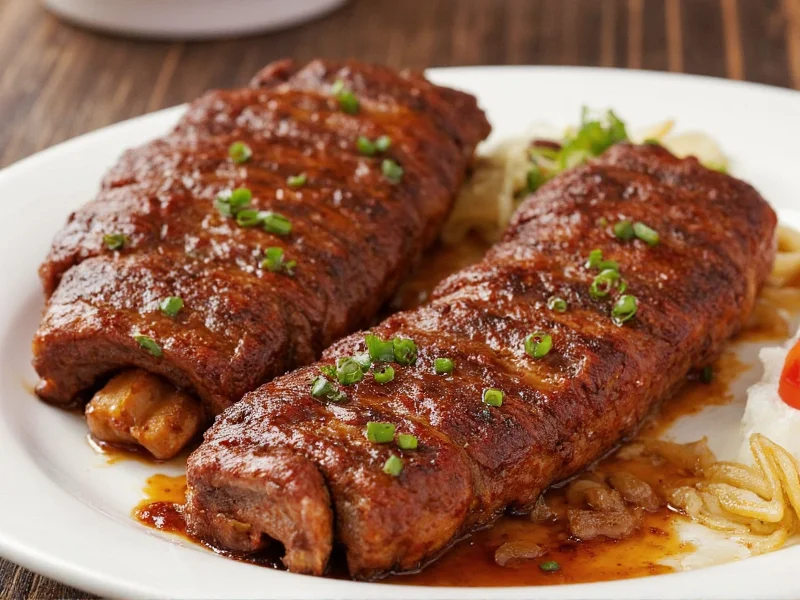When shopping for meat or browsing a restaurant menu, understanding the difference between beef and pork cuts is essential. The straightforward answer to "are short ribs pork" is no—they're a beef cut. This distinction matters for dietary preferences, religious restrictions, cooking methods, and flavor profiles.
What Exactly Are Short Ribs?
Short ribs come from the lower portion of a cow's rib cage, specifically from the brisket, chuck, plate, or rib sections. Despite the name, they're called "short" because butchers cut them shorter than traditional rib cuts to include the bone section that connects to the rib cage's cartilage.
These meaty, bone-in cuts contain layers of fat and connective tissue that break down during slow cooking, resulting in incredibly tender, flavorful meat. The marbling and bone structure make short ribs particularly well-suited for braising, smoking, or slow roasting.
Beef Short Ribs vs. Pork Ribs: Key Differences
Understanding the distinction between beef short ribs and pork ribs helps prevent confusion at the grocery store or butcher counter:
| Characteristic | Beef Short Ribs | Pork Ribs |
|---|---|---|
| Source Animal | Cow (beef cattle) | Pig |
| Common Names | Short ribs, beef short ribs | Spare ribs, baby back ribs, St. Louis style ribs |
| Bone Structure | Larger, denser bones with more meat | Smaller, more delicate bones |
| Fat Content | Higher marbling, more connective tissue | Less marbling, leaner |
| Typical Cooking Method | Slow braising, smoking (3-6 hours) | Grilling, smoking (3-5 hours) |
| Flavor Profile | Richer, beefier flavor | Sweeter, milder pork flavor |
Types of Beef Short Ribs
Not all short ribs are created equal. Butchers prepare them in different ways:
- English Cut: Cut parallel to the bone, resulting in individual rib portions with one bone each. This is the most common type found in supermarkets.
- Flanken Cut: Cut across the bones, creating strips with multiple small bone sections. Popular in Korean cuisine (as in galbi).
- Boneless Short Ribs: The meat has been removed from the bone, though this version lacks some of the flavor benefits that come from bone-in cooking.
- Plate Short Ribs: Come from the lower chest area and contain more fat, making them ideal for slow cooking.
Why the Confusion Between Beef and Pork Ribs?
The confusion around whether short ribs are pork stems from several factors:
- Terminology overlap: Both beef and pork have "ribs" in their naming, but "short ribs" specifically refers to beef.
- Menu ambiguity: Some restaurants might simply list "ribs" without specifying beef or pork, leading to confusion.
- Regional variations: In certain culinary traditions, the terminology might differ slightly.
- Butcher shorthand: At meat counters, staff might use abbreviated terms that aren't clear to consumers.
When in doubt, always ask for clarification about whether ribs are from beef or pork—this is especially important for those with dietary restrictions or preferences.
Cooking Short Ribs: Best Practices
Proper preparation makes all the difference with this cut:
- Slow cooking is essential: The connective tissue needs time to break down. Plan for at least 3 hours of cooking time.
- Browning first: Sear the meat before slow cooking to develop flavor through the Maillard reaction.
- Temperature matters: Cook at a low temperature (275-325°F) for optimal tenderness.
- Resting time: Allow cooked short ribs to rest for 15-20 minutes before serving to redistribute juices.
Popular cooking methods include braising in liquid (like red wine or broth), smoking, or using a slow cooker. The resulting meat should pull away from the bone easily while maintaining its structure.
Nutritional Comparison: Beef Short Ribs vs. Pork Ribs
For health-conscious consumers, understanding the nutritional differences matters:
- Beef short ribs: Higher in iron and zinc, with more saturated fat but also more conjugated linoleic acid (CLA), which may have health benefits.
- Pork ribs: Generally leaner than beef short ribs but still high in fat compared to other pork cuts.
A 3-ounce serving of cooked beef short ribs contains approximately 280 calories, 22g fat, and 21g protein. The same portion of pork spare ribs has about 275 calories, 20g fat, and 19g protein. Both provide significant amounts of B vitamins and minerals.
Common Misconceptions About Short Ribs
Several myths persist about this cut of meat:
- Misconception: Short ribs are a tough, undesirable cut.
Reality: When cooked properly, they're among the most tender and flavorful beef cuts. - Misconception: All short ribs are the same regardless of where they come from on the cow.
Reality: Plate short ribs have more fat and are better for braising, while chuck short ribs are leaner. - Misconception: You can cook short ribs quickly like steak.
Reality: They require slow, low-temperature cooking to become tender.
Shopping Tips for Short Ribs
When selecting short ribs, look for:
- Bright red meat with creamy white fat (avoid grayish meat or yellow fat)
- Good marbling throughout the meat
- Fresh butcher paper wrapping (not leaking)
- At least 1 inch of meat covering the bone
- Even thickness for consistent cooking
Fresh short ribs should be used within 2-3 days of purchase or frozen for longer storage. When frozen properly, they maintain quality for 6-12 months.











 浙公网安备
33010002000092号
浙公网安备
33010002000092号 浙B2-20120091-4
浙B2-20120091-4